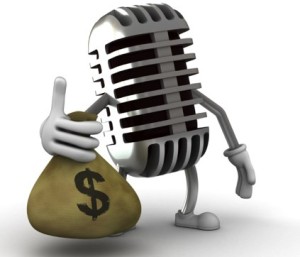 With all the free streaming radio these days, you have to wonder why anyone would want to pay for streaming online radio content. The latest cars have more than overkill. On the 2011 BMW you have AM/FM Radio, HD radio, satellite radio, CD/MP3 player, USB port, iPhone jack and an auxiliary plug. That’s . . .wait a minute, yeah, that’s 8 different options you have to listen to music! Don’t we love options? As human beings, that is one of the deciding factors in many things in life; having a lot of options. With the exception of SiriusXM, which is trading at a whopping $1.76 a share as I write, the rest of my options are pretty much free. That’s the other thing that goes great with humans and options; free!
With all the free streaming radio these days, you have to wonder why anyone would want to pay for streaming online radio content. The latest cars have more than overkill. On the 2011 BMW you have AM/FM Radio, HD radio, satellite radio, CD/MP3 player, USB port, iPhone jack and an auxiliary plug. That’s . . .wait a minute, yeah, that’s 8 different options you have to listen to music! Don’t we love options? As human beings, that is one of the deciding factors in many things in life; having a lot of options. With the exception of SiriusXM, which is trading at a whopping $1.76 a share as I write, the rest of my options are pretty much free. That’s the other thing that goes great with humans and options; free!In the sense of pay for play, most streaming music and media today is being monetized by advertisers. Just like in radio, TV and print before it, advertisers are proving to be the main force behind the monetization of online radio streaming. Sure, you have to buy the internet radio head option in your new Cooper, or Focus . . .and yeah, you have to pay for a 4G account, just like you have to pay for your TV, cable and the electricity to run it, but the meat of the meal is powered by the advertisers and not the listener.
There are listener sites like Pandora that have teetered on the brink of profitability because of the enormous royalty burden of being a pure-play model that’s now running ads to help monetize the traffic. It is the way of the internet. You establish heavy, targeted traffic and then feed geo and genre-targeted advertising to the site visitor/listener. This is what has powered all successful websites, from Google to Facebook, and music listener sites are no different. With all the options and choices out there, you cannot charge the customer unless you have something niche or premium.
There are so many smartphone apps for stations and tuner sites that you can literally be on the other side of the world, punch in your home zip code and start listening to the AM/FM spectrum from your hometown. All you are paying for is the bandwidth to get the signal from their servers to your ear, all in the timespan of 200 milliseconds or less. Again, the deadly words choice, option and free are the dearth of the pay-to-listen sites like Thumbplay, which recently was acquired by Clear Channel Radio, and while it’s still not clear exactly what their plans are, it’s a safe bet the venture capital firms have waived bye-bye to their $22 million in capital.
The winners in all of this are the radio station broadcasters and their listeners. Why, you ask? Because traditional radio continues to dominate with the online growing sector serving as an additional tool to reach listeners when they are not in their car, but when they are at work in their office, or at home on their PC, or out and about with their smartphone. The internet did not kill the radio star, it only made it brighter. And the listener? Well, you, the listener, the one that was brought up used to advertising everywhere you go, are the real winner. We are the winners of choice and free services, while at the same time creating one of the biggest advertising markets.
Because of the IP numbering method that connects the web together, advertisers can be even more geo and genre-targeted in their ad campaigns. This allows for better ad placement, dynamic feedback and response, and specific metrics that traditional advertising doesn’t offer. Online radio is here to stay, is in a major growth trend, and is the newest conduit by which advertisers will get their message to the market.
It already is and will be, advertising that powers the online listener . . . not paying a membership every month for what you can listen to for free!


